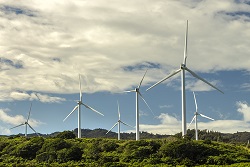As we've previously discussed in Oil & Energy Investor, major infrastructure for solar and wind power networks is complete, while the cost of generating power from either has reached grid parity with traditional sources of electricity.
And now there is a new centerpiece for the accelerating move to renewable energy...
Hawaii.
The state has opted to go all out on alternative energy. In May, its legislature overwhelmingly passed a plan to move to complete independence from fossil fuels for power generation. Governor David Ige has put a goal on all of this: 100% by 2045.
 Already, as the governor remarked in late August, "The state is creating a number of research institutions and working with a consortium of private companies in what it calls an 'Energy Excelerator,' which has generated $400 million in investment."
Already, as the governor remarked in late August, "The state is creating a number of research institutions and working with a consortium of private companies in what it calls an 'Energy Excelerator,' which has generated $400 million in investment."
But Hawaii has an unusual partner in moving away from its reliance on oil and natural gas:
The U.S. military.
What's happening in Hawaii may allow us to make some nice money from a state deciding to go green... and from the military's need to go off the grid...
New Oil- and Gas-Free Initiatives
You see, because of rising security concerns, the Navy, Army, and Air Force are dead set on generating one gigawatt each of their own energy from sources not based on the traditional grid.
The Navy wants to accomplish this in the next 18 months.
When the power goes out, whether because of an intentional attack or severe weather, military bases need to keep running. Relying on power from the traditional grid undermines their mission.
That's where Hawaii comes in...
Most of the state's existing power plants are in vulnerable areas, if not from enemy attack, then certainly from uncontrollable weather events.
A first initiative has produced two exciting developments...
One is the successful U.S. Navy initiative to produce electricity from tidal power. Marine Corps Base Hawaii on Oahu is getting some of its power from the first wave energy generator to be connected to a power grid in North America.
The second development is the Army's move into biofuels. Amanda Simpson of the Army Office of Energy Initiatives has said that "The planned biofuel electricity plant at Fort Schofield is the only power plant in the islands to be built inland."
Hawaii is likely to become a focus for a range of startups and combined private-public sector renewable energy projects moving forward. There is even talk underway of developing a recharging grid on several of the islands solely for the use of electric vehicles.
This last one may take some doing and points to the ongoing realization that a totally "oil- and gas-free" environment must confront transport sector energy needs.
Why Renewable Energy Isn't Declining
This marks a huge change from just last year.
Back then, residents of North Dakota, Western Texas/Eastern New Mexico, and the panhandle region of Ohio, West Virginia, and Pennsylvania had been leading the call for energy independence.
Only a year later, these basins are witnessing large reductions in forward capital expenditure commitments, a spike in energy debt likely to result in massive numbers of bankruptcies among small operating companies, and double-digit unemployment with higher levels on the way.
There are still a number of opportunities to make money in energy, even in oil and natural gas. The volatility hitting in waves, spurred on by over-aggressive (and largely self-serving) tides of shorts intent on driving prices below what market dynamics justify, along with the increasing usage of questionable derivatives, has certainly accentuated the concern.
[mmpazkzone name="in-story" network="9794" site="307044" id="137008" type="4"]
In the past, a reduction in crude oil and natural gas prices would have prompted a rise in the usage of both and a corresponding decline in interest to invest in alternatives.
Well, despite some choppy bouts with demand figures, the decline in prices has resulted in an increase in usage of oil and gas.
On the other hand, the other shoe hasn't fallen: Renewables haven't suffered.
In fact, as we've discussed in Oil & Energy Investor on several occasions, this time around, renewables have actually improved.
And on the back of this rise in renewables, Hawaii is fast becoming the new leader in energy independence...
This will present us with opportunities to make a profit, as Hawaii goes green and the military goes off the grid (or at least the kind of grid we have come to expect).
Follow us on Twitter @moneymorning.
What the Fed's "Hold" Means for Oil: The nine years of historically low interest rates will continue. Before Yellen decides to finally pull the trigger, we'll see price volatility spiral across all global markets - especially when it comes to crude. Consequently, the oil "doom and dread" crowd and their bearish predictions are running rampant. Here's why they're dead wrong...
About the Author
Dr. Kent Moors is an internationally recognized expert in oil and natural gas policy, risk assessment, and emerging market economic development. He serves as an advisor to many U.S. governors and foreign governments. Kent details his latest global travels in his free Oil & Energy Investor e-letter. He makes specific investment recommendations in his newsletter, the Energy Advantage. For more active investors, he issues shorter-term trades in his Energy Inner Circle.



